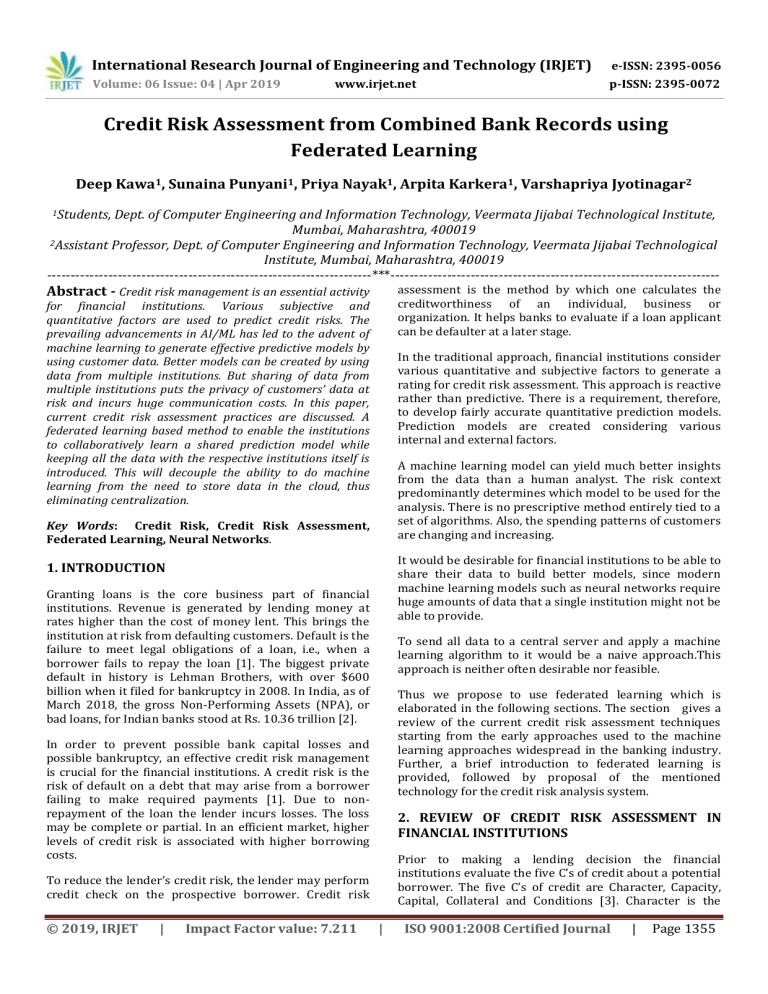
International Research Journal of Engineering and Technology (IRJET)
e-ISSN: 2395-0056
Volume: 06 Issue: 04 | Apr 2019
p-ISSN: 2395-0072
www.irjet.net
Credit Risk Assessment from Combined Bank Records using
Federated Learning
Deep Kawa1, Sunaina Punyani1, Priya Nayak1, Arpita Karkera1, Varshapriya Jyotinagar2
1Students,
Dept. of Computer Engineering and Information Technology, Veermata Jijabai Technological Institute,
Mumbai, Maharashtra, 400019
2Assistant Professor, Dept. of Computer Engineering and Information Technology, Veermata Jijabai Technological
Institute, Mumbai, Maharashtra, 400019
---------------------------------------------------------------------***----------------------------------------------------------------------
Abstract - Credit risk management is an essential activity
assessment is the method by which one calculates the
creditworthiness of an individual, business or
organization. It helps banks to evaluate if a loan applicant
can be defaulter at a later stage.
for financial institutions. Various subjective and
quantitative factors are used to predict credit risks. The
prevailing advancements in AI/ML has led to the advent of
machine learning to generate effective predictive models by
using customer data. Better models can be created by using
data from multiple institutions. But sharing of data from
multiple institutions puts the privacy of customers’ data at
risk and incurs huge communication costs. In this paper,
current credit risk assessment practices are discussed. A
federated learning based method to enable the institutions
to collaboratively learn a shared prediction model while
keeping all the data with the respective institutions itself is
introduced. This will decouple the ability to do machine
learning from the need to store data in the cloud, thus
eliminating centralization.
In the traditional approach, financial institutions consider
various quantitative and subjective factors to generate a
rating for credit risk assessment. This approach is reactive
rather than predictive. There is a requirement, therefore,
to develop fairly accurate quantitative prediction models.
Prediction models are created considering various
internal and external factors.
A machine learning model can yield much better insights
from the data than a human analyst. The risk context
predominantly determines which model to be used for the
analysis. There is no prescriptive method entirely tied to a
set of algorithms. Also, the spending patterns of customers
are changing and increasing.
Key Words: Credit Risk, Credit Risk Assessment,
Federated Learning, Neural Networks.
It would be desirable for financial institutions to be able to
share their data to build better models, since modern
machine learning models such as neural networks require
huge amounts of data that a single institution might not be
able to provide.
1. INTRODUCTION
Granting loans is the core business part of financial
institutions. Revenue is generated by lending money at
rates higher than the cost of money lent. This brings the
institution at risk from defaulting customers. Default is the
failure to meet legal obligations of a loan, i.e., when a
borrower fails to repay the loan [1]. The biggest private
default in history is Lehman Brothers, with over $600
billion when it filed for bankruptcy in 2008. In India, as of
March 2018, the gross Non-Performing Assets (NPA), or
bad loans, for Indian banks stood at Rs. 10.36 trillion [2].
To send all data to a central server and apply a machine
learning algorithm to it would be a naive approach.This
approach is neither often desirable nor feasible.
Thus we propose to use federated learning which is
elaborated in the following sections. The section gives a
review of the current credit risk assessment techniques
starting from the early approaches used to the machine
learning approaches widespread in the banking industry.
Further, a brief introduction to federated learning is
provided, followed by proposal of the mentioned
technology for the credit risk analysis system.
In order to prevent possible bank capital losses and
possible bankruptcy, an effective credit risk management
is crucial for the financial institutions. A credit risk is the
risk of default on a debt that may arise from a borrower
failing to make required payments [1]. Due to nonrepayment of the loan the lender incurs losses. The loss
may be complete or partial. In an efficient market, higher
levels of credit risk is associated with higher borrowing
costs.
2. REVIEW OF CREDIT RISK ASSESSMENT IN
FINANCIAL INSTITUTIONS
Prior to making a lending decision the financial
institutions evaluate the five C’s of credit about a potential
borrower. The five C’s of credit are Character, Capacity,
Capital, Collateral and Conditions [3]. Character is the
To reduce the lender’s credit risk, the lender may perform
credit check on the prospective borrower. Credit risk
© 2019, IRJET
|
Impact Factor value: 7.211
|
ISO 9001:2008 Certified Journal
|
Page 1355
International Research Journal of Engineering and Technology (IRJET)
e-ISSN: 2395-0056
Volume: 06 Issue: 04 | Apr 2019
p-ISSN: 2395-0072
www.irjet.net
2.2 Machine Learning Approaches
personal and business reputation of the borrower.
Capacity refers to the means in which the borrower will
repay the debt. Capital refers to the risk borrower is
willing to take. Collateral is the property used to secure
the loan. Conditions refers to financial conditions at the
time of the loan.
In recent years, machine learning as become popular in
the financial sector. Machine learning can be used in credit
risk analysis as with increasing amount of data ML can
give better insights compared to humans. Also, it is faster
than traditional approaches.
2.1 Early Approaches
Several models of machine learning have been tried on
the given problem, centering one bank, including linear,
logistic and multinomial regression by using elastic net
approach. Random forest and gradient boosting
algorithms have also been successfully tested [7].
Experimentally the random forests work better because
they are not constrained to predict linear or continuous
relationships. A machine learning model can yield much
better insights from the data than a human analyst. The
risk context predominantly determines which model to be
used for the analysis. There is no prescriptive method
entirely tied to a set of algorithms. A report by McKinsey
states that machine learning can reduce credit loses by
10% and credit decision times by 20-25% [9] [8]. Also, the
spending patterns of customers are changing and
increasing. Machine learning helps the lending institutions
by decreasing guesswork. AI based scoring models
combines customers credit history and the power of big
data to improve credit decisions.
The decision of granting credit to a borrower is based
on the financial health of the borrower indicated by a
rating assigned to them. The rating may be calculated
internally or provided by a third party like Moody’s,
Standard & Poor’s for a fee. The drawback of this approach
is the subjective aspect which leads to inconsistent
estimates.
At present, most institutions employ their own
prediction models to grant credit to clients. [4] shows that
there are two approaches to create these models structural and empirical. In structural approach, the
modelling is based on the dynamics of the borrower’s
characteristics such as a firm’s assets and balance sheets.
Under structural models, a default event is deemed to
occur for a borrower when the assets reach a sufficiently
low level compared to its liabilities. The main advantage of
these models is that they provide an intuitive picture and
understanding the reasons behind a default is simple. The
limitation of these models is that they are based on
assumptions of the borrower’s characteristics. In
empirical approach, the modelling of relationship between
the borrower’s characteristics and default is learned from
the data. It compares borrower’s characteristics with past
borrowers’ and predicts the outcome. Because empirical
models do not explicitly try to capture the economics of
default, they are much simpler. But unlike structural
models, empirical models are not intuitive.
Using predictive models make it difficult for institutions
to explain the scores to the customers. Several types of
risk models have a greater level of transparency as the
traditional methods. Gradient Boosting Machines (GBM)
are predictive models built from sequence of several
decision tree sub-models. The nature of GBM makes it
easier than deep learning or neural network algorithms to
explain the logic behind the model’s predictive behavior.
This is because GBMs are represented as sets of decision
trees that can be explained as opposed to the neural
networks that are represented as cryptic numbers that are
much harder to understand.
The following are some borrowers’ characteristics
considered for credit risk assessment:
●
●
●
●
●
Credit Score
Age
Income
Debts
Assets
3. FEDERATED LEARNING
Machine Learning models can be improved by using more
data by collecting data across different banks. Centralized
collection of data is not a feasible solution because of
following reasons:
Credit score determines the credit worthiness of an
individual. The credit reports and scores of the borrowers
are provided to the banks by the credit bureaus like Credit
Information Bureau (India) Limited also known as CIBIL,
partnered with TransUnion [5]. CIBIL collects and
analyses information on credit history of both the existing
and prospective borrowers. CIBIL provides a CIBIL report
and CIBIL-TransUnion score that takes credit utilization,
defaulting/delinquency and trade attributes into account
[6].
●
●
●
Banks would be reluctant to share their privacy
sensitive data with others due to business
reasons.
Security and management issues of training data
at the center.
Transfer of large amount of data over expensive
or unreliable network is difficult.
With increasing privacy concerns in today’s world,
centralized storage of data is considered vulnerable for
the above cited reasons. Federated Learning is a new
© 2019, IRJET
|
Impact Factor value: 7.211
|
ISO 9001:2008 Certified Journal
|
Page 1356
International Research Journal of Engineering and Technology (IRJET)
e-ISSN: 2395-0056
Volume: 06 Issue: 04 | Apr 2019
p-ISSN: 2395-0072
www.irjet.net
approach to machine learning where the training data
does not leave the client at all. Weight updates are
computed by the client using their locally available data,
instead of the data being shared. It is a collaborative form
of machine learning where the training process is
distributed among many clients. It enables devices to
collaboratively learn a shared model by keeping all the
training data on the device, without the need of
centralization [10][11][12].
Federated learning differs from the standard machine
learning techniques in that, the latter has more
independent and identically distributed data which is not
the case for the former. Devices used for federated
learning approach may be intermittently available, may
have higher latency, lower throughput. Work has been
done to improve the communication efficiency of the
technique. The result is the introduction of the Federated
Averaging Algorithm which requires 10-100x less
communication than the naive federated version of
Stochastic Gradient Descent. Also, the uploading costs are
reduced by another 100x by compressing the model
updates by random rotation and quantization. Federated
learning can significantly reduce privacy and security risks
by limiting the attack surface to only device rather than
device and the cloud.
Chart -1: Proposed Model for Loan Default Prediction
3. CONCLUSION
In this work, we have analyzed and presented the current
practices of credit risk assessment used by banks. We have
also proposed the use of federated learning for learning a
credit risk assessment model on data from a large number
of banks. The next step towards a real-life implementation
is to design a system for prediction of the risk on lines of
the idea presented taking into consideration the
communication and security aspects.
4. USAGE OF FEDERATED LEARNING IN THE
CREDIT RISK ASSESSMENT SCENARIO
REFERENCES
One approach to utilizing the data from all the banks for
training purposes would be to send the data from all
banks to a central server and apply algorithms to it. This is
not a viable solution because of the data breach
vulnerabilities and other business issues. Collecting data
at one place can increase the possibility and extent of
attacks.
1.
2.
We propose use of federated learning to perform credit
risk assessment. In the proposed design for this system, a
central authorized institution plays the role of a central
server, coordinating with the federation of clients i.e. bank
servers, where most of the work is performed.
3.
To begin with, an initialized model is present on the
server. A certain number of clients are randomly selected
to improve the model in Federated Learning. We propose
to select all the clients in every iteration to improve the
model, as the total number of banks in India is not huge
and every bank can be taken into consideration to build a
system, homogenous for all the banks. The current model
is received by each client from the server. Each client
trains the model using its local data. All the model updates
are then sent back to the server where they are
aggregated. The central model is updated with the
aggregate and sent to clients for further rounds. This
process is repeated till convergence.
© 2019, IRJET
|
Impact Factor value: 7.211
4.
5.
6.
|
O'Sullivan, Arthur; Sheffrin, Steven M.: Economics:
Principles in Action. Pearson Prentice Hall,
Upper Saddle River, New Jersey 07458 (2003)
India's bank non-performing loans rise to \$150.2
billion at end-March. Reuters, The Economic Times
(2018).
https://economictimes.indiatimes.com/markets/stoc
ks/news/indias-bank-non-performing-loans-rise-to150-2-billion-at-endmarch/articleshow/65120728.cms
Five C’s of Credit. In: Reviewer, Julia Kagan,
Investopedia(2018).
https://www.investopedia.com/terms/f/five-ccredit.asp
Amir F. Atiya, Senior Member, IEEE: Bankruptcy
Prediction for Credit Risk Using Neural Networks: A
Survey and New Results. IEEE TRANSACTIONS ON
NEURAL NETWORKS, Vol-12, Number-4 July (2001)
Grant of ‘Certificate of Registration’ – For carrying on
the business of Credit Information – CIBIL,
https://www.rbi.org.in/Scripts/NotificationUser.aspx
?Id=7046\&Mode=0
Daisy P.K.: A Study on Credit Information Bureau
(India) Limited (CIBIL). ERPA International Journal of
Economic and Business Review, Vol-4, Issue-3
March(2016)
ISO 9001:2008 Certified Journal
|
Page 1357
International Research Journal of Engineering and Technology (IRJET)
e-ISSN: 2395-0056
Volume: 06 Issue: 04 | Apr 2019
p-ISSN: 2395-0072
www.irjet.net
7.
Thitimanan Damrongsakmethee, Victor-Emil Neagoe:
Data Mining and Machine Learning for Financial
Analysis. Indian Journal of Science and Technology,
Vol-10(39) October (2017)
8. How machine learning can help banks rate credit
risk?,
https://www.artificialintelligencenews.com/2018/06/13/how-machine-learning-canhelp-banks-rate-credit-risk/
9. McKinsey On Risk. McKinsey and Company, Number 4, January (2018)
10. Federated Learning: Collaborative Machine Learning
without
Centralized
Training
Data,
https://ai.googleblog.com/2017/04/federatedlearning-collaborative.html
11. The
Amazing
Tech
Stack
of
OpenMined,
https://hackernoon.com/the-amazing-tech-stack-ofopenmined-a4a0b208d62e
12. Federated-Learning,
https://florian.github.io/federated-learning/
© 2019, IRJET
|
Impact Factor value: 7.211
|
ISO 9001:2008 Certified Journal
|
Page 1358




